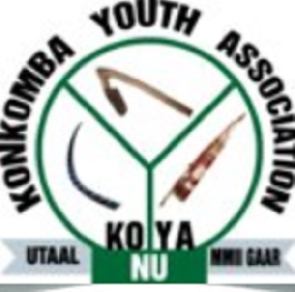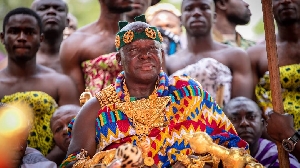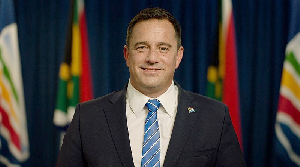Opinions of Monday, 24 July 2023
Columnist: Abubakari Is-haq Motariga
Doctored history of the Dagbamba people: A response to Konkomba Youth Association
Introduction:
Heightened inter-ethnic tensions precipitated by social media hateful comments by individuals and youth groups of Konkombas and Dagbambas have recently characterized public discourse in the Northern Region of Ghana. It is this situation which has made His Majesty, N’dan Ya-Na Abukari II, convene a meeting of major stakeholders to discuss possible solutions to de-escalate the region of the tension.
It is against this backdrop that government delegation including; the National Security Minister, Albert Kan-Dapaa, Minister for Chieftaincy and Religious Affairs, Hon. Stephen Asamoah Boateng, Defense Minister, Hon. Dominic Nitiwul, Minister of State at the Ministry of Finance, Hon. Mohammed Amin Anta, Deputy Minister of Transport, Hon. Alhassan Tampuli, Deputy Majority Chief Whip of Parliament, Hon. Habib Iddrisu, and Majority and Minority MPs were at the Gbewaa Palace of Dagbon on Tuesday 11th July 2023. Other stakeholders were Dagbon Youth Association (DAYA), Konkomba Youth Association (KOYA), and Dagbon Forum (DF).
This approach, though timely and responsive to the situation, is viewed by many as cosmetic, palliative, and fire-fighting if the stakeholders aim to nib this perennial crisis in the bud. Just last two years, on November 9, 2021, a similar meeting was held at the Gbewa Palace in Yendi. Past NGO and government functionary meetings and peace durbars on this same issue are countless.
In order to understand the current social media verbal banter, tensions, and rumours of an outbreak of inter-ethnic war between the Konkombas and the Dagbambas, major stakeholders have often asked the question; “Why are we here again?”
N’dan Ya-Na, King and Overlord of Dagbon minced no words in his speech when he observed inter alia that; “We and the Hon. Defense Minister and most have tread (sic) this path before and resolved to take certain actions, including apprehension of certain persons operating the social media spewing out hate speeches.” In a similar light, Naa Yeb’ Kuga-Na, like the DAYA, wondered why the security apparatus of the nation reneged on their promise of dealing decisively with perpetrators of the social media hateful speeches when faces are now known.
Generally, the National Security Minister, Defense Minister, and MPs from the Majority and Minority sides of parliament appeared helpless before the King of Dagbon and his subjects at the Gbewa Palace when questions about past promises were raised. New pledges to end this perennial crisis were made by government functionaries and major stakeholders.
KOYA, Dagbon Forum (DF), and DAYA through their leaderships assured the public that both Dagbamba and Konkomba ethnic groups are uninterested in ethnic clashes. No doubt this has a far-reaching effect in de-escalating the Dagbon area and the region as a whole of the tensions.
One may ask; “what are the causes of the numerous conflicts involving the Konkomba, Dagbamba, Nanumba, Mamprusi, and Gonjas since 1940 in the Northern Region? What has been behind the “Cow War” (1940) between Konkombas and Dagbamba, the “Pito War” (1981) between Konkombas and Nanumba, and the “Guinea Fowl War” (1994) between Konkombas and Nanumba, Dagbamba and Gonja.
How could these ethnic clashes be triggered by a mere cow, a mere guinea fowl, pito, or anything considered so paltry and inconsequential? Instead of looking at the immediate causes and tagging derogatory names, we must be interested in the remote causes of these conflicts.
Magal Kuunboln’s Pronouncements and KOYA’s Stance:
On 21st June 2023, Ubor Magal Kunboln I, a Konkomba/Basari chief of Tema, was hosted on Maranatha TV where he said many things which sparked the recent social media tension alarms. He dared the Dagbon Constitution Review Committee (DCRC), the King of Dagbon, the Dagbon Traditional Council, and Dagbanmba, in general, to take off portions of land captured in the Dagbon constitution or “…face a lot of serious resistance from Konkombas and the Basaris.”
The question of sovereignty and “traditional independence”, the crux of Magal’s statements, appears more apolitical agitation of KOYA and Konkomba elites than a ‘mere’ individual’s rants. It is difficult for Hon. Dominic Nitiwul, KOYA, or any Konkomba elite to call for Magal’s condemnation or arrest. Anybody in the shoes of Hon. Dominic Nitiwul, or that of any Konkomba elite, would naturally be surreptitious and uninterested no matter how you push him or them.
At KOYA’s 46th Annual Convention in April this year, the President, Jawol Bisunna Titus, had stated KOYA’s condition for peace in Dagbon and the Northern Region as; “…if we truly want to enjoy peace in the northern region of the country, then the government and other authorities responsible for chieftaincy and land should be ready to do the right thing by allowing justice to prevail because without justice there cannot be peace.
That is to say, the government and the state should do their best and facilitate the process that will enable the minority groups to have their paramount chiefs and traditional councils.”
This appears to be KOYA’s stance since its formation in 1978. This, to a large extent, is a recipe for chaos and a repetition of the bellicose verbal banters which has huge potential for full-blown ethnic wars as we have seen in 1981 and 1994. Aside from this, the Ghanaian public may wonder what may be wrong with us; judging from the dossier of wars involving the Konkomba since 1940.
I say so because the Konkomba elite’s understanding of justice is “Traditional independence” or autonomous Konkomba paramount chiefdom in which certain portions of Dagbon and Nanun lands would be ceded out to create what is to be known as ‘Ukpakpabor’ made up of chiefs (bor, ubor, uchabobor, uwumbor, etc). This belief, according to the Konkomba, stems from;
Numerical strength of the Konkomba
Their cultural and linguistic difference from other northern chiefly groups,
Their purported assertion that they inhabited the upper Oti River basin for three centuries that they occupy 90 percent of the Saboba/Chereponi District where the seat of their new paramountcy should be (specifically in Saboba).
It is based on these beliefs that a petition of Konkomba chiefs and opinion leaders was written in April 1993 and addressed to the National House of Chiefs. The petition was signed by eight ‘chiefs’ (bor, ubor) headed by Uchabobor Borwan Kwadin IV, as well as three opinion leaders including Kenneth Wujangi, the perennial president of the Konkomba Youth Association (KOYA) who played a crucial role already in the 1981 conflict.
Very controversially, the petition stated that ‘as early as the seventeenth century we were already inhabiting the entire Oti basin stretching from the Northern tip of the Northern Region to the Northern part of the present Volta Region”.
Perhaps, the most controversial is the statement that “Konkombas were forcefully put under either Dagomba traditional authority or that of the Mamprusi, Gonjas, and Nanumbas by the apostles of the Policy of indirect rule, and wrongly described as stateless people without chiefs or central authority”. This statement appears to be the core of Magal’s comments on Maranatha TV on Wednesday 21st June 2023.
The Konkomba petition was referred back to the authors with the suggestion that N’dan Ya Naa, the allodial title holder of Dagbon lands, should first see it. The version sent to N’dan Ya Naa was dated October 10 and sent on October 19, 1993.
The text appeared identical with the original petition except the point 4 about the Konkomba settlement of the entire Oti basin since the seventeenth century which was omitted, although both versions reached the Ya Naa.
Ya-Na’s Reply:
On October 22nd, 1993, N’dan Ya-Na refuted most of the Konkomba claim stating among others that the petitioners; “…falsely or ignorantly claimed that the Konkomba were forcibly put under the authority of Dagomba, Mamprusi, Gonja, and Nanumba.
He added; “If the Konkombas are denying that they are stateless, then which is their state? Where is it? If they are denying the fact that they have no chiefs who centrally control them, where are those chiefs? The petitioners cannot deny that the headmen they recognise today as their chiefs are Saboba Na, Nafeba-Na, Sanguli-Lana, and Nambil-Lana were appointed only a few years ago by Sunson-Na an appointee of the Ya-Na.”
Additionally, he noted that; “The British at no time forcibly put the Konkombas under the rule of the Dagombas. The Dagombas lived with some Konkombas many years before the advent of the white man in Northern Ghana. The British could not forcibly put the Konkombas under Nanun or Ngbanya. Konkombas only settled there long after the establishment of indirect rule in Northern Ghana.
In Mamprugu the Konkombas who were there at the advent of the white man were so few and insignificant that ‘the apostles of indirect rule’ took no notice of them. The Konkombas came from Togo and settled on our land. If they no longer want to be part of our establishment, then they have to go back home. They cannot be given any land in Dagbon to establish a second home in addition to their home in Togo.”
N’dan Ya Naa concluded his letter with an attack on KOYA as the brains behind the 1993 petition. It noted that “The Institution of Chieftaincy is neither a Youth Club nor a Youth Association. Chieftaincy in Ghana is a heritage given to us by history and tradition.
It is not an institution created by statute law or by the whimsical wishes of a Youth Association. It is not everyone in Ghana who is a Chief or who can be a Chief. I find it strange that it is the Konkomba Youth Association which is not part of the Institution of Chieftaincy that sent to me the request for Paramountcy.
The request and the procedure followed by the Petitioners show that were the demand to be granted, the institution of Chieftaincy which has a long history and tradition in Dagbon in particular and Ghana in general will degenerate into a Youth Club or Association and lose the respect given to it by the people of this country.
It is the view of the Dagomba Traditional Council that nobody should bastardize Chieftaincy or participate in the bastardization of the institution of Chieftaincy in Ghana. It is our proud heritage and must remain so. It is an institution our forefathers established which European Colonisers accepted as good and we have entrenched it in all our Constitutions”.
These statements from the King and Overlord of Dagbon would naturally embitter the petitioners in no certain measure. If one is a youth or an elder among the Konkomba brethren and can read and understand the import of the response, one would abhor it with the intellect and might it deserve.
It is by no means an affront to the Konkomba elite’s agitation since 1978. Tensions went high and the least provocation could trigger an inter-tribal blood bath.
Amidst these tensions, a 12-member government delegation held a meeting of chiefs and opinion leaders at the Presidential Lodge in Tamale. This was on the 21st of December, 1993. At the meeting, both the Nayiri and the representatives of the Bimbila Na told the delegation that the Saboba Na had gone to the wrong quarter (sic) to make his demand for paramount skin.
They observed again that; “What the Konkombas are requesting for is not within the authority of the government…it is solely within the preserve of the Ya-Na and the Dagbon Traditional Council.”
DAYA on 28th December 1993 issued a statement in support of the position of the chiefs. They noted, “That the land of Dagbon bequeathed to us through the blood, sweat, and enterprise of our revered forebears shall be preserved as our patrimony and ancestral birth-right and any attempt to expropriate any portions of it shall be resisted by all legal means possible.”
As there was a delay in finding solutions to the crisis, the tensions escalated in both divides. It is this situation which culminated in the 1994 “Guinea Fowl War”.
DAYA’s Press Statement:
On 3rd July 2023, DAYA held a press conference at Aliu Mahama Sports Stadium in Tamale where they, among other things;
Called on KOYA to join in condemning Magal Kuunboln for the inflammatory comments Called on the national security to immediately arrest Magal Kuunboln
Called for the President of Ghana to reshuffle Hon. Dominic Nitiwul from the Defense Ministry Called on KOYA and Konkomba chiefs and people to justify their claim of the indigeneity of Dagbon lands.
Point iv appears to be the fundamental issue that has made most Konkomba elites join KOYA’s incessant call on government to come in and settle the land and chieftaincy dispute. It is natural for one to resent a system of peace and justice if it fails to reverse to you your ancestral lands which have been expropriated by latter-day Dagomba settlers.
Whether it was done through persuasion, conquest, or by the help of a white man, the Konkomba would inherently view the perceived or real marginalization of their tribesmen through the lens of “traditional independence” in which their lands are rightfully re-appropriated.
KOYA’s Response to DAYA:
On 6th July 2023, KOYA released its response to DAYA’s call for justification of autochthony. KOYA based their historical claims of Konkomba aboriginality on Emmanuel F. Tamakloe’s “A Brief History Of The Dagbamba People”.
KOYA in their presser referred everyone to page 14 where they quoted Tamakloe as; “There is an account of Sitobo's travels to find his son, Na Nyagse. The events coming after that annoyed his (Sitobo's) brothers, the second of whom was called Bogoyelgo. "Second of these was Bogoyelgo who with his party went away from Sitobo in Bagale. He went and established himself in Sunson among the Kpamkpamba people." (Page 14).
They further quoted the author; “The Ngbanya people still held parts of the Dagbamba country adjacent to the eastern side of the White Volta, and had encroached so far as to threaten the capital town Yendi. To avoid this incessant fighting with the Ngbanya, Na Luro deemed it expedient to abandon the capital and to build a new one in the Kpamkpamba country. Na Luro occupied the Kpamkpamba town Chare, the people of which went and built Wangbun on the Demon road. Chare became Yendi from that time." (Page 27)”
If we all accept to use of Tamakloe’s work as sacrosanct to delineate historical territorial boundaries to settle the dispute, the Konkomba argument appears lame, doctored, and a misrepresentation that may not stand the test of intellectual and historical debate. In doing this, care must be taken not to elevate Tamakloe’s book or any other documented source over the well-preserved oral tradition from the “Lunsi” clan (griots or drum historians) traditionally dedicated to such purpose.
Much of what KOYA relied on is in reference to the Political History of Dagbon and not the history of the Dagbamba people. KOYA, like many historians, appears to have conveniently chosen to rely on the history of Naa Gbewaa and his descendants to settle the historical land dispute between the Konkomba and the Dagomba.
The subsequent pages of Tamakloe’s book cannot be enough justification for Konkomba's aboriginality in Dagbon. What some historians such as David Tait 1958, J. Akoto Okoro 2008, Froelich 1954, Kenneth Kitinkawa, and Z. A. Mahama 1986 among others have done is to mutilate the history of the Dagbamba to lay the foundation for Konkomba aboriginality.
Because KOYA referred readers of their presser to E. F. Tamakloe, one is compelled to largely stay with the author to agree or disprove the widely held notion that Dagbamba is Naa Gbewa’s descendants who only arrived in the 14th Century at time which the Konkomba tribe had inhabited the area.
On pages 1 and 2 of the ‘sacred’ Tamakloe books, one finds that the author has shed light on the broader subject matter. He, Tamakloe, writes;
“It is said that, after the confusion of tongues, the tribe of Ad, who were descended from Ad, the son of Uz, the son of Aram, son of Shem, son of Noah, settled in the Province of Hadramaut, where their posterity greatly multiplied. This tribe continued to worship God; but in the process of time, they fell from the worship of the true God into idolatry.
God seeing this sent the prophet Heber to preach and reclaim them. But when they refused to acknowledge his mission, God sent a hot and suffocating wind which blew seven nights and eight days together and which, entering into their nostrils passed through their bodies and destroyed them all save the very few who had believed in Heber. This tribe we learned, were of prodigious stature, the tallest of them being said to be a hundred cubits or a hundred and fifty feet in height and the least of them sixty cubits or ninety feet.
This tribe, it is said, wandered towards the East and the West, settling in uninhabited countries [emphasis mine] till they arrived in the country which is today called" Dagbon"; and their progeny were called “Dagbamba." The first towns built by them were said to be Gunayiri in Karaga District, and Yoggo in Toma or Safulugu District, and those of them who settled beyond the Oti river were the progenitors of the Kpamkpamba (Konkomba) races [emphasis mine].
Tradition has it that some of these giants, namely 3 men and women from Yoggo and 7 men and women from Gunayiri, emigrated again from their settlements and founded Nanumba and Adele, and others again became the progenitors of the Akebus, Bowiris, etc, etc.”
Tamakloe further writes; “The Adites multiplied greatly and were known as the Dagbambas. They had no kings save the fetish priests who exercised more or less sway over their fellow subjects. … They remained in this deplorable condition till Na Nyagse, the great-grandson of Kgogonumbo, made war against them, killed the entire body of fetish priests of the Dagbamba, and appointed his sons, brothers, and nephews chiefs in their stead about the year 1416 A.D.”
This view appears quite acceptable in that the mythological construction about the legendary Tohazei’s (The Red Hunter) migration from Zamfara towards present-day Ghana is unambiguous. Almost all history books hold the view that Tohazei, the Red Hunter, was alone when he arrived from Zamfara. That he met a certain tribe from whom he married after killing a wild beast and gave birth to Kpogonombo who moved further, married from another tribe, and gave birth to Shitobu, the father of Na Nyagse.
What this means is that at any place, the progenitors of the ruling class arrived they intermarried with the indigenous people, and their children were integrated into the dominating tribe’s culture. This is the most probable reason the Dagbamba who had lived years in Nanung, Dagbon, and Mamprugu before the arrival of the ancestors of the ruling class have linguistic and cultural similarities rather than the widely held view that they are descendants of Na Gbewa.
One may ask; “Why then has this history, except the history of the chieftains, been unknown to many to the extent that history books at Primary, JHS, SHS, and University levels have generally held this view that Dagbamba are descendants of Naa Gbewa or Tohazei the Red Hunter?
Tamakloe provides us with a seeming answer to this. He notes carefully that; “The general opinions held on these subjects are altogether misleading and result from the confusion caused by our common answer to a white man "Yes Sir" without having established in the first place a basis of understanding and truth between the questioner and questioned.
I may also presume that the narrators from whom the various misrepresentations have been culled are no competent traditionists and if they are such, it might probably be that, for fear of their Chiefs paramount, whose resentment they cannot easily escape for exposing their origin which is secretly kept in awe, the traditionists deem it no offence in these circumstances to utter a falsehood to mislead a stranger.”
I belong to the Laabansi clan of Dagbon. I don’t belong to the chiefly class, neither could I be a Na of Yendi. My grandfathers have constantly told me how our ancestors migrated to Dagbon long before Na Gbewa arrived at Pusiga.
Like the Butchers (Nakohinima) clan, the Lunsi (griots) clan, the Machenima (Blacksmith) clan, the Sapashini nima (traditional warriors) clan, et cetera et cetera, a lot of oral tradition has said about their migratory routes to present day Dagbon long before Na Gbewa arrived to consolidate all these clans under his authority.
When Na Nyagse arrived, the ‘chiefless’ clans were either to surrender and subjugate their traditions, including their history, to that of the conqueror or be exterminated. This, to a large extent, coupled with less civilization and writing culture at that time is probably the reason much is unknown about these early Dagbamba.
It is apparent that KOYA’s claim of Konkomba aboriginality is unconvincingly lame and incredulously fanatical if we again put emphasis on Tamakloe’s words; “…settling in uninhabited countries”.
Besides, Tamakloe points to a place beyond the Oti River, probably beyond the boundaries of Ghana, and most likely Togo, where the Konkomba may have settled first before these early Dagbamba settlers arrived. Attention should be placed on; “…and those of them who settled beyond the Oti River were the progenitors of the Kpamkpamba (Konkomba) races. Anybody with basic Geography of Ghana understands that the Oti River is roughly close to the Togo boarder.
E. F. Tamakloe in 1910 was employed in the Northern Territories Administration as a Census Clerk in the Eastern and Western Dagbon. He had, in his early days been an Interpreter stationed in Kete Krachi where he had the opportunity of collecting information about the “Emigration of the Kagbanye People” for Julius Graft von Zech, and the histories of the Dagbambas, Moshis, and the Hausas for Adam Mischlich between 1897 – 1907.
Like many historians who have eschewed pedantry and egotism, Tamakloe has provided a holistic approach to the history of the Dagbamba race. Conventional narrations, or what I call a holistic approach, indicate that the early history of the Dagbamba falls within two periods; the era of the ‘commoners’ and the Earth Priests, Tindaamba before Naa Gbewaa the conquest of the indigenes and the consolidation of the ruling class known in the Dagbani dialect as Nabihi up to colonial rule and beyond.
Any historian who depends on the latter to conclude that Dagbambas are descendants of Tohazei the Red Hunter is murdering their history. Both the rulers and the ruled came to present-day Dagbon in two different periods.
Giving an account of the history of the Dagbamba, Ibrahim Mahama (2004: 1) noted that: “The name Dagbamba which has been anglicized as Dagomba belongs to the commoners. The rulers adopted that name and many aspects of the life of the people they conquered and established over them their sovereignty.
It was also the language of the conquered people that the rulers adopted. Indeed, the culture and customs of the Dagomba which did not militate against the sovereignty of the conquerors were readily adopted by them. Customs that conflicted with their aims and aspirations were modified if not for the whole of the new Kingdom but at least for their line of descent.
They discarded the existing matrilineal system of inheritance except in some aspects where it was beneficial to them. They intermarried with the local population and placed all the offspring of their marriage in the ruling class. Except in the political and to some extent social hierarchies, the fusion of the two groups is complete.
They speak the same language; they are engaged in similar work; they are governed by the same customs and traditions; in physical appearances, there are no distinguishing features; in short, they are all one.
As can be seen, KOYA has rather crafted a misrepresentation of Dagbamba history with dubious interpretations that Dagbamba people only arrived in the 1400s at which time some ethnic group identified as the Konkomba had occupied the territory.
These misnomer and misleading interpretations, however popular they may be, only represents the history of the conquest of Dagbon by the conqueror, Na Gbewa, and his descendants, not the history of the conquered or the indigenous people. It is by far an exaggerated and convenient conjecture habituated so carefully because aboriginal Dagbamba history has been eclipsed by the history of the ruling class or ‘Nanima’.
KOYA relying on Tamakloe also appears to admit, albeit with guile interpolations, that early Dagbamba who were organized under clan heads and Earth priests (Tindaambas), in acephalous groups or clans, were the ones Na Nyagse met and not the Konkomba tribe.
The presser notes; “It was after this that Na Nyagse embarked upon killing various Dagbamba fetish priests [emphasis ours] and appointing his sons, brothers, and uncles as chiefs. This was between 1416 and 1432. (Pages 16-18)”.
The reader of this quote is left to wander if Na Nyagse was actually one of the early Dagbamba and how hilarious could it be that Na Nyagse would become so demented to killing his own people and appointing his sons, brothers, and uncles as chiefs.
Tamakloe also notes on page 13 that “Na-Nyagsi …took the field against the Dagomba people, first he went to the West and then to the East, fought with and massacred all Dagomba fetish priest [emphasis mine] and appointed his sons, brothers, and uncles as chiefs in their stead.”
This point is also made by Rattray (1932) although he referred to the aboriginal people east and west of Dagbon as “Dagban sabelese” (the Black Dagomba). (See Rattray, 1932, pg 563).
All these point to something more than the history of Na Gbewa. If our subject matter is the history of the Dagbamba people, it serves a better purpose to take a holistic approach rather than mutilating history to suit our interests. This certainly is a doctored, concocted, and misinterpreted history of the Dagbamba people.
Conclusion:
To assume that the war of words is over is to tickle oneself and laugh. The John Jagiri’s, the Bashiru Bijejugu, et cetera et cetera will not end the social media verbal diarrhea and arrow of war jargon because there was a meeting at the Gbewaa Palace. We have often allowed ignorance, misinformation, and deliberate disinformation to continually prepare fertile fields for perennial heightened tensions in the Northern Region.
We must read and read well so that our conceptions or misconceptions of history as they interact with our perceptions of land rights and discrimination are clear to us.
Reporting on the avoidable 1994 inter-ethnic war under the heading “War Up North”, a correspondent of Uhuru Magazine Vol. 6, No. 2 had this to say: “A devastation of unimaginable proportions had taken place within a short period of 10 days as Konkombas locked horns with Gonjas, Nanumbas, and Dagombas.
In these 10 days of mayhem, more than 1000 people died and over 150 villages were burnt down. Corpses of children and adults littered the streets, some with arrows stuck in their heads and bowels with their intestines gusting out”. This is a dark aspect of our history that everyone must guard against.
The wars of the past and the present war of words are avoidable if we read and read well. If the bases of our tensions and agitations stem from our history of appropriation or expropriation of lands, then there is absolutely no need to continue especially if we use Tamakloe’s book which KOYA refers us to.
The condition for peace ie “Traditional Independence” for Konkomba chiefdom is therefore baseless and needless if we have to lose innocent lives and properties.
If it must persist, it must probably be settled first by archaeological findings of who and who settled where first and when. Whether that would even end the crisis is for the law of Ghana, the courts, the government, and the chieftaincy institution to answer.
War certainly has no winner and no loser; except innocent lives being lost, some maimed and thousands and thousands of properties being destroyed. This would always worsen the poverty situation of the Northern Region; with the most hit being rural folks whose livelihoods depend on a day-to-day struggle for meals.
Bertrand Russel noted that “War does not determine who is right – only who is left”. “There is no glory in battle worth the blood it costs” Dwilight D. Eisenhower.
Shalom! Peace to KOYA, my Konkomba friends, elders, and chiefs.
Shalom! Peace to DF and DAYA, my Dagomba friends, elders, and chiefs.
Shalom! Peace to the Northern Region of Ghana and Ghana as a whole.
Do forgive me where I have faulted.
Reference:
Emmanuel F. Tamakloe’s (1931) “A Brief History Of The Dagbamba People”, Printed at the Government Printing Office, Accra.
Rattray, R. S. 1932. The Tribes of the Ashanti Hinterland. 2 vols. Oxford: Clarendon Press.
Tait, D. 1961. The Konkomba of Northern Ghana (J. Goody ed.). London: Oxford University Press.
Mahama, I. 2004. History and Traditions of Dagbon. Published and Printed by GILLBT Printing Press. Tamale: Northern Region, Ghana
Mahama I. Ethnic Conflicts in Northern Ghana
Tamakloe, E. F. 1931b. “Mythical and Traditional History of Dagomba,” in: Cardinall, A. W. Tales Told in Togoland, London: Oxford University Press
Petr Skalník University of Hradec Králové, University of Wroclaw, Political Anthropology of History: The Case of Nanun, Northern Ghana
KOYA President’s Speech at KOYA 46TH Annual Convention at Saboba, 1st April 2023
KOYA Press Release, 6th July 2023.
DAYA Press Statement, 3rd July 2023
Joint KOYA-DF Press Release, 6th July 2023













